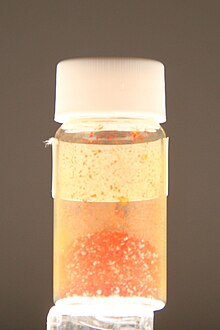Antimony triiodide
| |||
 | |||
| Names | |||
|---|---|---|---|
| IUPAC name Antimony triiodide, Antimony(III) iodide | |||
| Systematic IUPAC name Triiodostibane | |||
| Identifiers | |||
CAS Number |
| ||
3D model (JSmol) |
| ||
| ChemSpider |
| ||
| ECHA InfoCard | 100.029.278 | ||
| EC Number |
| ||
PubChem CID |
| ||
| UNII |
| ||
CompTox Dashboard (EPA) |
| ||
InChI
| |||
| |||
| Properties | |||
Chemical formula | I3Sb | ||
| Molar mass | 502.473 g·mol−1 | ||
| Appearance | red crystals | ||
| Density | 4.921 g/cm3 | ||
| Melting point | 170.5 °C (338.9 °F; 443.6 K) | ||
| Boiling point | 401.6 °C (754.9 °F; 674.8 K) | ||
Solubility in water | soluble, partially hydrolyses | ||
| Solubility | soluble in benzene, alcohol, acetone, CS2, HCl, KI, SnCl4, C2H7N ,HI,alkali metal triiodides insoluble in CHCl3, CCl4[1] | ||
| Solubility in diiodomethane | 10.15% v/v (12 °C)[2] | ||
| -147.0·10−6 cm3/mol | |||
| Structure | |||
| Rhombohedral, hR24, | |||
| R-3, No. 148 | |||
| 1.58 D | |||
| Thermochemistry | |||
Heat capacity (C) | 81.6 J/mol·K (gas)[1] | ||
Std enthalpy of formation (ΔfH⦵298) | -100.4 kJ/mol[1] | ||
| Hazards | |||
| GHS labelling:[4] | |||
  | |||
| Warning | |||
| H302, H332, H411 | |||
| P273 | |||
| NIOSH (US health exposure limits): | |||
PEL (Permissible) | TWA 0.5 mg/m3 (as Sb)[3] | ||
REL (Recommended) | TWA 0.5 mg/m3 (as Sb)[3] | ||
Except where otherwise noted, data are given for materials in their standard state (at 25 °C [77 °F], 100 kPa).  N verify (what is N verify (what is  Y Y N ?) N ?) Infobox references | |||


Antimony triiodide is the chemical compound with the formula SbI3. This ruby-red solid is the only characterized "binary" iodide of antimony, i.e. the sole compound isolated with the formula SbxIy. It contains antimony in its +3 oxidation state. Like many iodides of the heavier main group elements, its structure depends on the phase. Gaseous SbI3 is a molecular, pyramidal species as anticipated by VSEPR theory. In the solid state, however, the Sb center is surrounded by an octahedron of six iodide ligands, three of which are closer and three more distant.[5] For the related compound BiI3, all six Bi—I distances are equal.[6]
Production
It may be formed by the reaction of antimony with elemental iodine, or the reaction of antimony trioxide with hydroiodic acid.
Alternatively, it may be prepared by the interaction of antimony and iodine in boiling benzene or tetrachloroethane.
Uses
SbI3 has been used as a dopant in the preparation of thermoelectric materials.[7]
References
- ^ a b c "Antimony triiodide".
- ^ Seidell, Atherton; Linke, William F. (1952). Solubilities of Inorganic and Organic Compounds. Van Nostrand. Retrieved 18 May 2017.
- ^ a b NIOSH Pocket Guide to Chemical Hazards. "#0036". National Institute for Occupational Safety and Health (NIOSH).
- ^ Sigma-Aldrich Co., Antimony(III) iodide. Retrieved on 2014-05-29.
- ^ Hsueh, H.C.; Chen, R.K.; Vass, H.; Clark, S.J.; Ackland, G.J.; Poon, W.C.K.; Crain, J. (1998). "Compression mechanisms in quasimolecular XI3 (X = As, Sb, Bi) solids" (PDF). Physical Review B. 58 (22): 14812–14822. Bibcode:1998PhRvB..5814812H. doi:10.1103/PhysRevB.58.14812. hdl:20.500.11820/6b565e3e-900c-465c-a037-6929e8a7c18b. S2CID 121883973.
- ^ Holleman, A. F.; Wiberg, E. "Inorganic Chemistry" Academic Press: San Diego, 2001. ISBN 0-12-352651-5.
- ^ D.-Y. Chung; T. Hogan; P. Brazis; M. Rocci-Lane; C. Kannewurf; M. Bastea; C. Uher; M. G. Kanatzidis (2000). "CsBi4Te6: A High-Performance Thermoelectric Material for Low-Temperature Applications". Science. 287 (5455): 1024–7. Bibcode:2000Sci...287.1024C. doi:10.1126/science.287.5455.1024. PMID 10669411.
External links

- v
- t
- e
| HI +H | He | |||||||||||||||||
| LiI | BeI2 | BI3 +BO3 | CI4 +C | NI3 NH4I +N | I2O4 I2O5 I4O9 | IF IF3 IF5 IF7 | Ne | |||||||||||
| NaI | MgI2 | AlI AlI3 | SiI4 | PI3 P2I4 +P PI5 | S2I2 | ICl ICl3 | Ar | |||||||||||
| KI | CaI2 | ScI3 | TiI2 TiI3 TiI4 | VI2 VI3 | CrI2 CrI3 | MnI2 | FeI2 FeI3 | CoI2 | NiI2 -Ni | CuI | ZnI2 | GaI GaI3 | GeI2 GeI4 +Ge | AsI3 As2I4 +As | Se | IBr IBr3 | Kr | |
| RbI RbI3 | SrI2 | YI3 | ZrI2 ZrI3 ZrI4 | NbI4 NbI5 | MoI2 MoI3 | TcI3 | RuI3 | RhI3 | PdI2 | AgI | CdI2 | InI InI3 | SnI2 SnI4 | SbI3 +Sb | TeI4 +Te | I− I− 3 | Xe | |
| CsI CsI3 | BaI2 | LuI3 | HfI3 HfI4 | TaI4 TaI5 | WI2 WI3 WI4 | ReI3 ReI 4 | OsI OsI2 OsI3 | IrI3 IrI 4 | PtI2 PtI4 | AuI AuI3 | Hg2I2 HgI2 | TlI TlI3 | PbI2 | BiI3 | PoI2 PoI4 | AtI | Rn | |
| Fr | RaI2 | Lr | Rf | Db | Sg | Bh | Hs | Mt | Ds | Rg | Cn | Nh | Fl | Mc | Lv | Ts | Og | |
| ↓ | ||||||||||||||||||
| LaI2 LaI3 | CeI2 CeI3 | PrI2 PrI3 | NdI2 NdI3 | PmI3 | SmI2 SmI3 | EuI2 EuI3 | GdI2 GdI3 | TbI3 | DyI2 DyI 3 | HoI3 | ErI3 | TmI2 TmI3 | YbI2 YbI3 | |||||
| AcI3 | ThI2 ThI3 ThI4 | PaI4 PaI5 | UI3 UI4 | NpI3 | PuI3 | AmI2 AmI3 | CmI3 | BkI 3 | CfI 2 CfI 3 | EsI2 EsI3 | Fm | Md | No | |||||












